Dry fasting is a type of fasting where you don’t consume food or water for a certain period. Although it has recently been growing in popularity in the modern world, dry fasting is ancient and has been in use for thousands of years, mainly for religious purposes.
Although it has recently been growing in popularity in the modern world, dry fasting is ancient and has been in use for thousands of years, mainly for religious purposes.
It can be performed for a limited period or be combined with intermittent fasting for long term use.
IMPORTANT: Do not under any circumstances attempt to go without water for more than 24-48 hours at a time. It doesn’t matter how many articles and expert advice you may come across on the internet, going without water for more than three days can lead to severe consequences and may even be fatal in some extreme cases (think hunger strikes and starvation).
What Is Dry Fasting?
As stated above, dry fasting is a fasting protocol that doesn’t allow water or any liquid consumption whatsoever for a certain period. It has been practiced since ancient times, mainly for religious and spiritual reasons.
For examples, many Christians practice dry fast on certain days of the week or during certain days of the calendar. Muslims practice dry intermittent fasting during the month of Ramadan where they go without food and water for roughly 12-20 hours per day. Pregnant women and those with certain health conditions are usually exempted from the religious fastings.
Can I Do Dry Fasting While on Keto?
Going without food or water is not a fun experience but doing it on the ketogenic diet may be more comfortable than doing it on a high carb diet. This is because when you do a dry fast while on a high carb diet, your body will use the stored glycogen as glucose for energy and then switch to ketogenesis when the stored glycogen level depletes. Once the glycogen level becomes insufficient, your body will convert fatty acids into ketones for fuel.
If you’re already on the ketogenic diet, you’re making it easier for the body to use fat for fuel from the moment you start your dry fast. Being fat adapted will also reduce any discomforts you may experience such as headaches, hunger, and thirst.
Another interesting fact is that 100 grams of beta-hydroxybutyrate produce 10 500 grams of Adenosine Triphosphate (ATP); whereas 100 grams of glucose produces 8 700 grams of ATP 1.
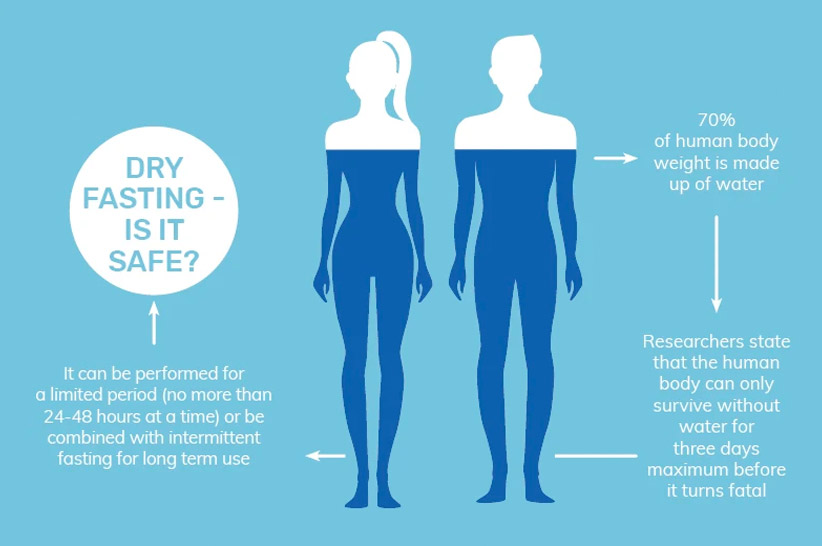
ATP plays a vital role as an energy carrier, and since ketone bodies produce more of it than glucose, it also means they’ll give you more energy to keep going through the dry fast than glucose.
Dry fasting done correctly can also help get into ketosis faster, especially if you happen to fall prey for an occasional cheat meal.
Is Dry Fasting Safe?
While fasting does have some proven health benefits, extreme forms of fasting such as prolonged dry fasting can lead to starvation related consequences. In some cases, it can result in degeneration and death 2.
70% of your body weight is made up of water, and that should hint its importance for survival. As far as research is concerned, you can survive without food for several weeks and usually up to 30 days before starvation symptoms begin to invade.
Water, however, is a different story. Many research papers and news journals state that the human body can only survive without water for three days maximum before it turns fatal. There have also been reports where some people survived for eight days or more without water, but in those cases, they barely survived and had health complications to recover from right after being rescued. And they usually survived by drinking their urine or by eating snow.
For instance, Paul Hanks, a 54-year-old Southern California attorney survived five days lost in the desert by drinking his urine and eating cactus until the rescue team found him 3. He went on a hiking trip to celebrate his birthday with only a couple of energy packs and a few hours worth of water. He had an accident and fell 20 feet deep where he fought for survival for five days. Hanks said he ran out of the water by the first night and had to refill his bottle with his urine.
In another similar incident, a 59-year-old man met with an accident where his car was stuck in between two trees and made it impossible for him to get out. He drank his urine to survive for five days before being spotted by a man walking his dog 4.
Another 54-year-old woman from California survived for ten days on the snow melting on her car windows. She took a wrong turn in the mountains, and her car got stuck in the snow, and she ran out of gas as well. She sipped on the one bottle of water she had and survived for ten days by eating snow and keeping warm using some extra clothes she had in the car 5.
Notice how the news articles linked above say “survived,” and that’s precisely what they mean. Those people barely survived for a few days without water by drinking their urine and eating snow in some cases.
If you want to do the dry fast for its therapeutic uses, you should do it the correct way which we’ll go through in a bit to make sure you’re getting the best out of it.
Types of Dry Fasting
Intermittent dry fasting
This is when you’ll set a time window to fast and eat during the day. You can either dry fast for 16 hours and eat during the 8-hour time frame or fast for 20 hours and eat during a 4-hour time frame. The former is considered to be a more familiar and ideal approach.
This is the fasting that Muslims practice during the month of Ramadan. They would eat and drink during the early morning hours and fast for the rest of the day (12-20 hours).
Prolonged dry fasting
Prolonged dry fasting is when you go without food or water for more than 24 hours. This type of fasting is not recommended because of all the reasons discussed in the previous section. Your body needs water to function and going without water for more than three days can lead to severe consequences and may even be fatal in some cases.
Besides, you don’t have to go to the extremes of prolonged fastings to reap the health benefits of dry fasting.
Absolute dry fasts
This is when some people choose to have absolutely no contact with water during their dry fast in the form of bathing, brushing, washing, etc. As far as research is concerned, there are no added benefits to this type of fasting and if anything, it might increase any discomforts.
Stages of Dry Fasting
Glycogen for fuel
Depending on your level of physical activity, 12-24 hours of fasting will reduce the blood glucose by 20% or more. When the body runs out of glucose during dry fasting, it will use the glucose stored in the form of glycogen, primarily in the liver, for energy.
Ketogenesis
When the glycogen level is insufficient to support the body’s needs, it enters a state called ketogenesis where stored adipose tissue fatty triglycerides are released in the form of fatty acids and glycerol 6. Some of those fatty acids can be directly oxidized by the liver and muscle for energy, but the brain can’t use fatty acids for fuel, so it gets converted into ketones to be used as fuel.
If you’re already fat adapted by practicing the ketogenic diet, your body is already using fat for fuel instead of glucose, and thus it will make it easier to transition on while on the dry fast.
Being fat adapted will also reduce any discomforts such as thirst and hunger you may experience during the dry fast.
How to Dry Fast the Right Way
STEP 1: Check if you’re suitable for it.
Dry fasting may not be suitable for everyone, so please discuss with your doctor to see if it’s safe for you.

In general, attempting a dry fast may not be suitable if:
- You’ve no experience in fasting at all, especially water fasting because this will give you an idea of how your body responds to starvation and if you might have any side effects.
- People who suffer from chronic headaches or migraines are not suitable for fasting in general unless it’s a medically supervised fast 7.
- Those who have diabetes should not undergo fasting without medical supervision and attempting to do so can increase the risk of adverse glycemic events 8.
- Some medications and drugs, even some supplements should not be taken on an empty stomach. If you happen to take medications, you need to consult with your doctor if it’s safe for you to perform a dry fast.
- Those with blood pressure problems and/or cardiovascular problems should also avoid unless permitted by the doctor.
STEP 2: Try to become fat adapted.
As stated earlier, becoming fat adapted through a diet like the ketogenic diet can make it easier to perform the dry fast with minimal discomforts because your body will produce more metabolic water from fat than via glycogen. It can take anywhere between 3-6 weeks to become fat adapted and here’s a two-week plan to help you get started on the keto diet.
It will be worth taking the time to prepare before you dive in to reap the full benefits of dry fasting without any significant adverse effects.
STEP 3: Start with water fast first.
It’s better to experiment with water only intermittent fasting for a week before trying the dry fast. Practice the 16:8 fasting protocol for a week with water only. This means you can drink water during the 16 hours of fasting time and eat your food during the 8-hour time window per day.
Doing this would give your body some time to get used to the act of fasting and let you know your body’s tolerance towards long fastings.
STEP 4: Go slow.
Following a successful water intermittent fasting, you should prepare your body further by cutting down on calories day by day for another week. You should also make sure you’re eating plenty of healthy fats and lower or completely take away any caffeine consumption during this time.
STEP 5: 16 hour dry fast.
By now you should have a better view of how your body will likely react on a dry fast, and if you’ve come to this step without any side effects, you can go ahead with a 16 hour dry fast without drinking or eating anything.
Rehydrate your body during the 8-hour time frame.
STEP 6: Decide your fast duration.
The 16:8 dry fast is generally considered to be safe so you can do it for a week or more but a week would be more than enough.
Depending on how you feel during and after the first 16:8 dry fast, you can decide if this is something you want to practice in the long run or not. If you choose to practice the dry fast in the long term, one day a week or one week a month (or one week every two months) would be an ideal and sustainable approach.
On the other hand, if you experienced any adverse effects that had a significant impact on the quality of your life, this is a sign you need to take a break and stick with water fasting instead.
Benefits of Dry Fasting
Majority of the studies conducted on dry fasting are based on Ramadan dry intermittent fasting in which the Muslims fast without food and water for 12-20 hours and eat during the early morning hours for 30 days. You can follow a similar approach for a day or a week, but it’s recommended to stick with the 16:8 protocol where you can fast for 16 hours and eat during the 8 hours time frame.
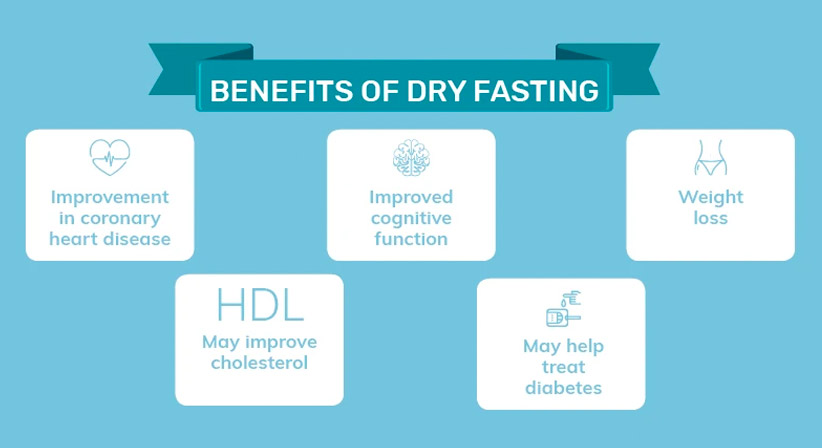
Improvement in coronary heart disease
A 2012 Ramadan dry intermittent fasting study found that participants had a significant improvement in 10 years coronary heart disease score 9.
Improved cognitive function
Fasting has been found to enhance cognitive performance in several studies. For dry fasting, we’ll discuss a study conducted on Ramadan intermittent dry fasting. A 2017 study found out that serotonin, BDNF, and NGF were increased during the fasting month 10. These are signaling molecules that play a vital role in cell growth, survival, and functioning of neurons.
The Brain-Derived Neurotrophic Factor (BDNF) has been found to enhance neurogenesis. It also plays a vital role in memory and learning because hippocampus (required for long term memory) is an essential site of BDNF 11.
Weight loss
Any weight loss achieved from fasting alone will likely be some water weight that you will quickly gain back once you start eating again. However, if you’re following a healthy diet like the keto diet, you can use fasting to enhance your weight loss journey.
For instance, 43 healthy medical staff members who practiced the Ramadan fasting participated in a 2016 study where their body weight, composition, waist to hip ratio, etc, were measured during the 28 days of fasting and 4-5 weeks after. By the 28th day, they found that the participants had a significant reduction in body weight, BMI, and body fat. However, they returned to their normal weight when they were measured again after 4-5 weeks 12.
May improve cholesterol
A 2013 study found that Ramadan fasting improved lipid profile and increased the high-density lipoprotein (good cholesterol) by 30-40% 13.
May help treat diabetes
A 2014 Ramadan study found that the intermittent dry fasting improved blood cholesterol and glucose in diabetic patients. The study concluded that diabetic patients might be able to safely do the fast after consulting their doctor 14.
Risks of Dry Fasting
Dehydration
This is more likely to happen if you weren’t well hydrated before you started the fast and/or if you happen to participate in activities that cause you to sweat more. For example, running while doing a dry fast can cause dehydration because you’ll sweat and lose more water when you’re already short on it.
You’re not suitable
We discussed who would not be ideal for a dry fast earlier and if you fit any of those but still chose to do the fast anyway, you might be risking yourself to experience some severe side effects. Those on medications, those who have certain health conditions like diabetes or heart problems, and pregnant or breastfeeding women shouldn’t do the dry fast unless permitted by a doctor.
Falling prey for misinformation
The last thing you’d ever want to do is to watch a youtube video of someone claiming to have done the dry fast for more than three days and attempted to follow their path. As discussed earlier, going without water for more than three days can lead to severe consequences and may even be fatal in some cases.
Other common side effects of dry fasting can include:
- Headaches
- Dizziness
- Tiredness
- Weakness
Takeaways
Dry fasting is a type of fasting where no water or food is allowed, and it has been practiced for thousands of years, mainly for religious purposes. Dry fasting can provide some therapeutic benefits for the body if done correctly and the best approach to do it is to combine it with intermittent fasting as discussed in step by step instructions we’ve given on this article.
Please discuss with your doctor before trying dry fasting and do not under any circumstances, attempt to go without water for more than three days. Dry fasting for 12-20 hours followed by a dehydration meal is the perfect way to approach it. You can do it once a week or once a month but try your best to follow the step by step instructions we’ve talked about.
Becoming fat adapted using the ketogenic diet will make it easier to do the dry fast because your body is already running on ketones for fuel. You may also experience fewer discomforts than you would if you do the dry fast on a high carb diet.





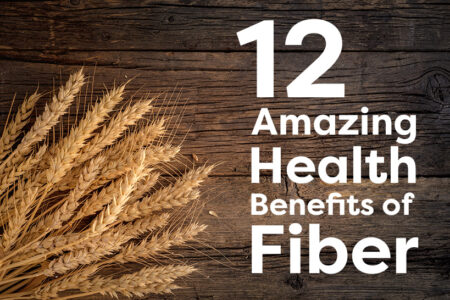
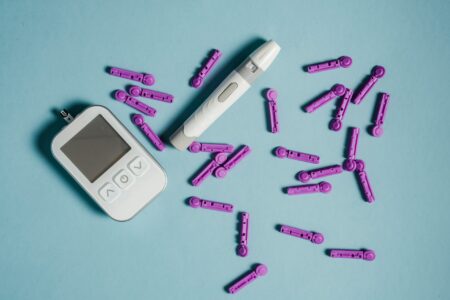

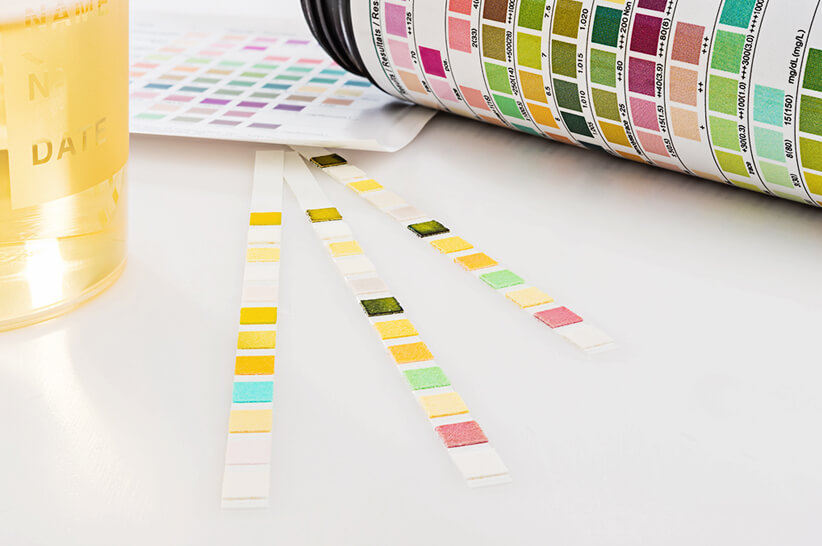

![Juicing for Weight Loss: Everything You Need to Know [Plus Recipes]](/wp-content/uploads/2019/08/Juicing-for-Weight-featured-image.jpg)









Excellent resource on dry fasting!
Thank you so much for the feedback! We’re glad you like the resource we made. 🙂